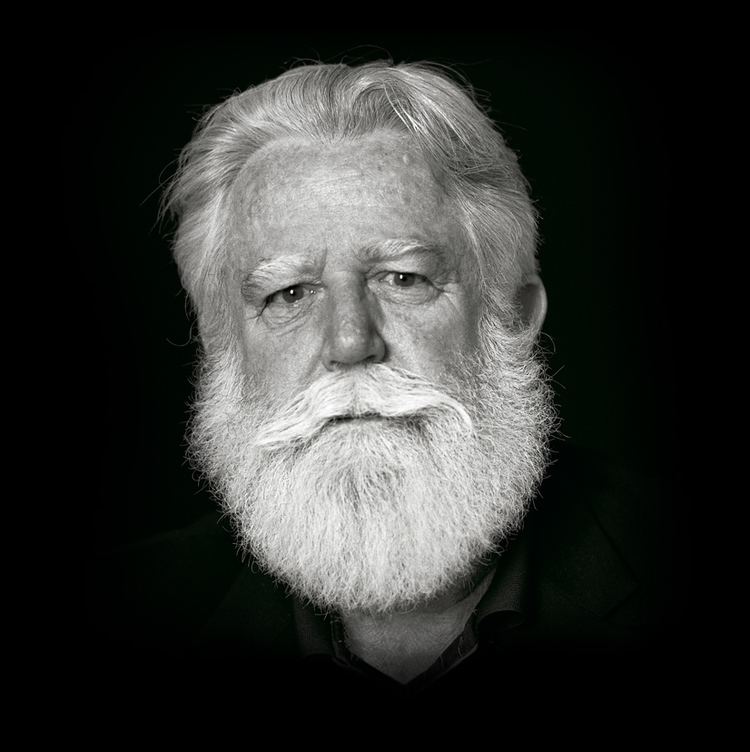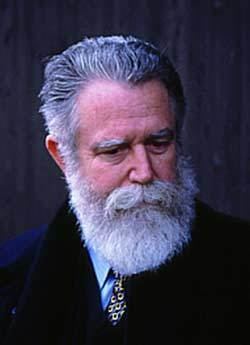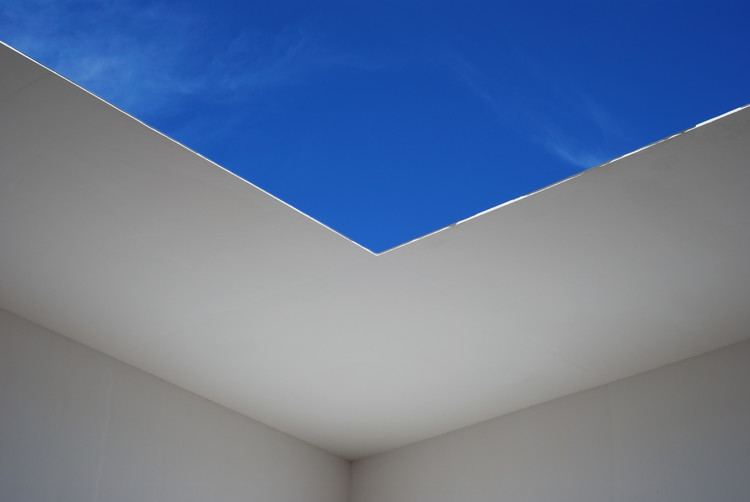Nationality American Name James Turrell Role Artist | Spouse Kyung-Lim Lee Website jamesturrell.com | |
 | ||
Born 6 May 1943 (age 82) ( 1943-05-06 ) Los Angeles Education Parents Archibald Milton Turrell, Margaret Hodges Turrell Awards MacArthur Fellowship, Guggenheim Fellowship for Creative Arts, US & Canada, Wolf Prize in Arts Artwork Acton, Stuck Red/Stuck Blue, A Frontal Passage Similar People Robert Irwin, Dan Flavin, Olafur Eliasson, Kiki Smith, Chris Burden | ||
Artist james turrell speaks about light
James Turrell (born May 6, 1943) is an American artist primarily concerned with light and space. Turrell was a MacArthur Fellow in 1984. Turrell is best known for his work in progress, Roden Crater, a natural cinder cone crater located outside Flagstaff, Arizona that he is turning into a massive naked-eye observatory.
Contents
- Artist james turrell speaks about light
- Artist james turrell abbreviated version
- Background
- Early work
- Roden Crater
- Skyspaces and other works
- Exhibitions
- James Turrell Museum
- Collections
- Awards
- Films
- References

Artist james turrell abbreviated version
Background
James Turrell was born in Los Angeles, California. His father, Archibald Milton Turrell, was an aeronautical engineer and educator. His mother, Margaret Hodges Turrell, trained as a medical doctor and later worked in the Peace Corps. His parents were Quakers.

Turrell obtained a pilot's license when he was 16 years old. Later, registered as a conscientious objector during the Vietnam War, he ended up flying Buddhist monks out of Chinese-controlled Tibet. Some writers have suggested it was a CIA mission; Turrell called it "a humanitarian mission" — and that he found "some beautiful places to fly". For years he restored antique airplanes to support his "art habit".

He received a BA degree from Pomona College in perceptual psychology in 1965 (including the study of the Ganzfeld effect) and also studied mathematics, geology and astronomy there. Turrell enrolled in the graduate Studio Art program at the University of California, Irvine in 1966, where he began making work using light projections. His studies at UC Irvine were interrupted in 1966, when he was arrested for coaching young men to avoid the Vietnam draft. He spent about a year in jail. He later (1973) received an MA degree in art from Claremont Graduate University. In 2004, he was awarded an honorary doctorate by Haverford College.
Early work

In 1966, Turrell began experimenting with light in his Santa Monica studio, the Mendota Hotel, at a time when the so-called Light and Space group of artists in Los Angeles, including Robert Irwin, Mary Corse and Doug Wheeler, was coming into prominence. By covering the windows and only allowing prescribed amounts of light from the street outside to come through the openings, Turrell created his first light projections. In Shallow Space Constructions (1968) he used screened partitions, allowing a radiant effusion of concealed light to create an artificially flattened effect within the given space. That same year, he participated in the Los Angeles County Museum's Art and Technology Program, investigating perceptual phenomena with the artist Robert Irwin and psychologist Edward Wortz.

In 1969, he made sky drawings with Sam Francis, using colored skywriting smoke and cloud-seeding materials. A pivotal environment Turrell developed from 1969 to 1974, The Mendota Stoppages, used several rooms in the former Mendota Hotel in Santa Monica which were sealed off, with the window apertures controlled by the artist to allow natural and artificial light to enter the darkened spaces in specific ways.
Roden Crater
Turrell is perhaps best known for his work in progress, Roden Crater. He acquired an extinct cinder volcano located outside Flagstaff, Arizona in 1979. Since then he has spent decades moving tons of dirt and building tunnels and apertures to turn this crater into a massive naked-eye observatory for experiencing celestial phenomena.
Although he works in the American desert, Turrell does not consider himself an earthworks artist like Robert Smithson or Michael Heizer: "You could say I'm a mound builder: I make things that take you up into the sky. But it's not about the landforms. I'm working to bring celestial objects like the sun and moon into the spaces that we inhabit." He added: "I apprehend light — I make events that shape or contain light."
The completion date for the Crater has been pushed back several times for funding and construction reasons, with the artist missing early targets in the 1990s. The last time Turrell or his team went on record talking about a completion date, the goal was 2011; but according to a 2013 article in the Los Angeles Times, "nobody volunteers a date any more."
Access to Roden Crater is limited to friends, though devoted fans can gain access by completing the "Turrell Tour", which involves seeing a Turrell in 23 countries worldwide. During May 2015, Roden Crater was open to a select group of 80 people, as part of a fund raiser, by allowing visits of 20 people per day during the course of four days, at a cost of $6,500 per person.
As Roden Crater has been long shrouded in secrecy, fans have attempted to sneak in without the artist's permission. Some have succeeded.
Skyspaces and other works
In the 1970s, Turrell began his series of "skyspaces" enclosed spaces open to the sky through an aperture in the roof. A Skyspace is an enclosed room large enough for roughly 15 people. Inside, the viewers sit on benches along the edge to view the sky through an opening in the roof. As a lifelong Quaker, Turrell designed the Live Oak Meeting House for the Society of Friends, with an opening or skyhole in the roof, wherein the notion of light takes on a decidedly religious connotation. (See PBS documentary). His work Meeting (1986) at P.S. 1, which consists of a square room with a rectangular opening cut directly into the ceiling, is a recreation of such a meeting house. In 2013, Turrell created another Quaker skyspace, Greet the Light, at the newly rebuilt Chestnut Hill Friends Meeting in Philadelphia.
In a New York Times article on L.A. collectors building skyspaces in their backyards, Jori Finkel describes a skyspace as a " celestial viewing room designed to create the rather magical illusion that the sky is within reach -- stretched like a canvas across an opening in the ceiling."
In 1992, James Turrell's Irish Sky Garden opened at the Liss Ard Estate, Skibbereen, Co Cork, Ireland. The giant earth and stoneworks has crater at its center. A visitor enters through a doorway in the perimeter of the rim, walks through a passage and climbs stairs to enter, then lies on the central plinth and looks upwards to experience the sky framed by the rim of the crater. "The most important thing is that inside turns into outside and the other way around, in the sense that relationships between the Irish landscape and sky changes" (James Turrell).
Since 2009, Turrell's Third Breath, 2005 is part of the permanent exhibition of the Centre for International Light Art (CILA) in Unna, Germany. It is a Camera obscura, consisting of two rooms: In the lower, cubic room (Camera Obscura Space), the visitor sees an image of the sky which is being reflected through a lens on the ground. In the upper, cylindrical room (Sky Space), the sky can be seen directly through a hole in the ceiling.
Other Skyspaces include the Kielder Skyspace (2000) on Cat Cairn, England, Knight Rise (2001) at the Scottsdale Museum of Contemporary Art, Second Wind (2005) in Vejer de la Frontera, Spain, and the Sky-Space (2006) in Salzburg, Austria. Three Gems (2005) at the de Young Museum is Turrell's first Skyspace to adopt the stupa form. At Houghton Hall in Norfolk, the Marquess of Cholmondeley commissioned a folly to the east of the great house. Turrell's Skyspace presents itself from the exterior as an oak-clad building raised on stilts. From the inside of the structure, the viewer's point of view is focused upwards and inevitably lured into contemplating the sky as framed by the open roof.
Turrell is also known for his light tunnels and light projections that create shapes that seem to have mass and weight, though they are created with only light. His work Acton is a very popular exhibit at the Indianapolis Museum of Art. It consists of a room that appears to have a blank canvas on display, but the "canvas" is actually a rectangular hole in the wall, lit to look otherwise. Security guards are known to come up to unsuspecting visitors and say "Touch it! Touch it!"
Turrell's works defy the accelerated habits of people especially when looking at art. He feels that viewers spend so little time with the art that it makes it hard to appreciate.
Art critic John McDonald writes that Turrell's works are "dull to describe but magical to experience."
Exhibitions
Turrell was given his first solo show at the Pasadena Art Museum in 1967. Solo exhibitions have since included the Stedelijk Museum (1976); Whitney Museum of American Art, New York (1980); Israel Museum (1982); Museum of Contemporary Art, Los Angeles (1984); MAK, Vienna (1998–1999); Mattress Factory, Pittsburgh (2002–2003); and the National Gallery of Australia in 2015.
There is also an exhibit at Rice University titled the Twilight Epiphany Skyspace.
In October 2009, the "Wolfsburg Project," Turrell's largest exhibition in Germany to date opened and continued through October 2010. Amongst the works featured in the "Wolfsburg Project" is a "Ganzfeld," a light installation that covers 700 square meters in area and 12 meters in height. A major retrospective will open at four different venues in 2013: the Academy Art Museum in Easton, MD opening in April, the Los Angeles County Museum of Art opening in May, and both the Museum of Fine Arts, Houston and the Solomon R. Guggenheim Museum, New York opening in June. Turrell has a permanent exhibit inside the Louis Vuitton store at CityCenter in Las Vegas. The work is known as Akhob.
Also in 2009, the opening of the artwork Third Breath, 2005 at the Centre for International Light Art in Unna, Germany, was accompanied by the four-month exhibition James Turrell - Geometry of Light.
From June 21 through September 25, 2013 the Solomon R. Guggenheim Museum presented James Turrell, the artist's first exhibition in a New York museum since 1980. The exhibition focused on the artist's explorations of perception, light, color and space. A major new project, Aten Reign (2013), recast the Guggenheim rotunda as an enormous volume filled with shifting artificial and natural light.
In 2015, Turrell created an artistic illumination of Houghton Hall as part of the LightScape festival celebrating the house and gardens.
In early 2017, his work was featured in the solo exhibition, Immersive Light, at the West Bund Long Museum Shanghai.
James Turrell Museum
In April 22, 2009, the James Turrell Museum opened at the Bodega Colomé in the Province of Salta, in Argentina. It was designed by Turrell after Donald Hess, owner of the winery and several of Turrell's works, told him he wanted to dedicate a museum to his work. It contains nine light installations, including a skyspace (Unseen Blue, 2002) and some drawings and prints.
Collections
Turrell's work is represented in numerous public collections including the Tate Modern, London; the Centre for International Light Art, Unna; the Mattress Factory, Pittsburgh; Los Angeles County Museum of Art; the Solomon R. Guggenheim Museum, New York; the Henry Art Gallery, Seattle; Walker Art Center, Minneapolis; the de Young Museum, San Francisco; the Indianapolis Museum of Art, Indianapolis; the Israel Museum, Jerusalem; the Spencer Museum of Art, Lawrence, Kansas; and Hansol Museum, Wonju, Varese (Italy) Panza Foundation.
In Japan, Turrell's works are exhibited at several large museums, including the 21st Century Museum of Contemporary Art, Kanazawa and a permanent installation at the Chichu Art Museum at Benesse Art-Site in Naoshima. At the latter, Turrell's work Afrum - Pale Blue (1968), Open Field (2000) and Open Sky (2004) are displayed. As part of the Naoshima town exhibitions, his Minamidera ("Southern Temple") was designed together with architect Tadao Ando. Also, in Tokamachi, Niigata, Turrell's House of Light has a view of the sunrise through the open roof that has been described as "the almost imperceptible change into deep blue was incredibly moving".
Awards
Turrell has received numerous awards in the arts including The John D. and Catherine T. MacArthur Foundation Fellowship in 1984 and the National Medal of Arts in 2013.
